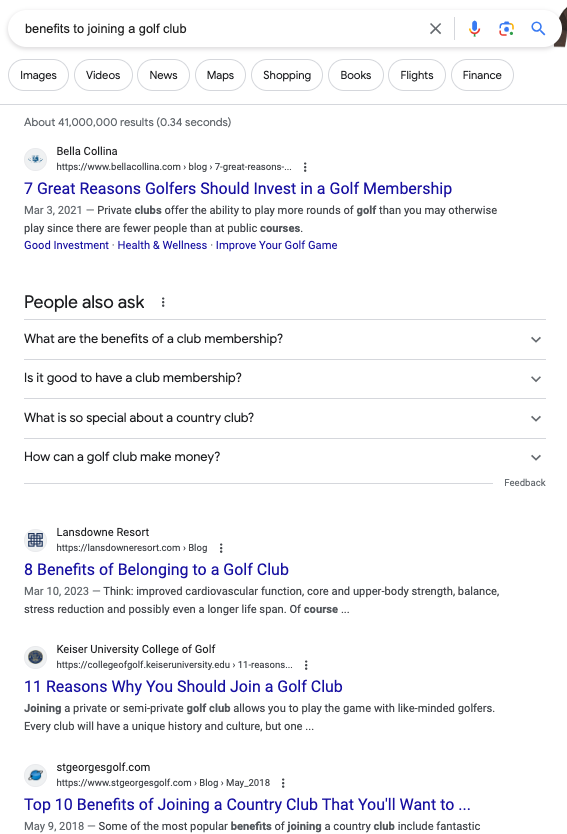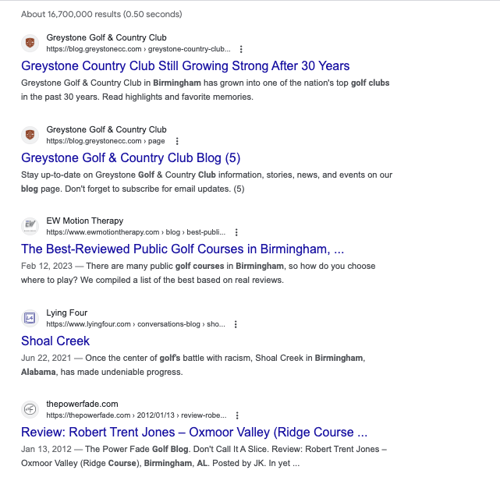Creating a Video Strategy to Grow Club Revenue and Reduce Expenses [Episode 12]
Look around online and it’s hard not to find video. From social media feeds to websites, video is everywhere. Yet it’s not enough to produce one...
7 min read
 Kathy Heil
:
Oct 23, 2023 2:30:00 PM
Kathy Heil
:
Oct 23, 2023 2:30:00 PM
You love your monthly newsletter, right? It’s a time-tested way to highlight upcoming events, feature the chef's specials, let the members know about club improvements, etc. It's a format that started with paper newsletters and the e-versions still serve as a valuable touchpoint for many members.
But as the audiences for those newsletters also start to get cold, it's worth considering content marketing as the next generation of club communications. Done well, content marketing (particularly blogging) can be a two-for-one tool to help you connect with existing members by giving them the right information at the right time, and help you generate new leads by turning your best internal stories into external messages.
I am not suggesting there isn’t value in newsletters. Your open rates will tell you that members do read (or at least glance at) newsletters. They are an effective way to keep members engaged and informed.
So don't worry, I'm not going to tell you to give up newsletter writing. In fact, here is a great resource to help you create more effective newsletters. But I want to address a different communication challenge facing club marketers today, and I am not sure they even know it exists. How do you reach members who don't read your newsletters, and how can you leverage your communication strategies to recruit new members?
We’ve seen some improvement in clubs’ communication efforts compared to 10 years ago, when many clubs were still relying on brochures, statement stuffers, direct mail, and flyers as top tactics for member communication–content marketing didn’t make the cut.
However, we still run into clubs and general managers who haven’t fully grasped the power of their digital footprint and content marketing. Over the last 10 years, our day-to-day interactions in the digital world have changed dramatically. Clubs must take that into consideration when driving new memberships and communicating with existing members–especially for the next generation members. It’s vital that clubs follow the “engage, entertain, and evaluate” principles when crafting a content marketing strategy.
Perhaps the reason content marketing isn’t at the forefront for most club marketers today is simply due to a lack of understanding—of the concept itself or how it can actually address both internal and external communications in unique ways.
Just to be clear about what we mean by content marketing, let's use the Content Marketing Institute's definition:
Content marketing is a strategic marketing approach focused on creating and distributing valuable, relevant, and consistent content to attract and retain a clearly defined audience — and, ultimately, to drive profitable customer action.
If you’re trying to attract new members and new events, or other business to your club, understanding content marketing can be an extremely valuable marketing tactic to increase your online visibility, and support your growth efforts.
We can’t talk about content marketing without talking about blogging, as oftentimes the terms content marketing and blogging are used interchangeably. Business blogging is a marketing tactic that uses blogging—the regular creation of new blog posts—to get your business more online visibility. A blog is a marketing channel (just like social media, direct mail, email marketing, etc.) that helps support business growth.
There are many “technical” benefits of having a blog such as helping to drive traffic to your website and helping to convert a visitor to a lead. In addition, it helps establish website authority with Google, which can have an “external” communications impact.
However, clubs can also leverage the flexibility and adaptability of blogging to deliver significant "internal" communications results.
So, how do you turn your blog into a two-for-one tool to connect with members and generate new leads? I'm glad you asked.
Related Blogs: |
Whether your newsletter is sent out weekly, bi-weekly, or monthly, it’s typically one version and sent to everyone on your distribution list. You’re not going to send one version to a family, one to a junior member, one version to a social member, and a separate version to a golf member because it’s hard enough to have the time to create one newsletter. Right?
When you publish a blog, (and we would recommend you publish several blogs a month) it typically is tailored to one audience, is written about one topic, and takes the reader deeper into a subject of interest. Not all members care about the same things and giving them a choice to “opt-in” to the communications that matter most can create the engagement you are looking for.
If you want to create a connection with a reader, there’s no better way to be memorable than with storytelling. A blog is a blank canvas that is waiting to be filled with your members’ stories. They can be written, they can be video, they just need to be told.
Let’s say your club had a member who had been playing tennis for 50 years and recently won a national Senior Tennis Player Tournament. You could mention this in your newsletter and provide a photo and some highlights OR you could write a blog post introducing the reader to the member. The blog could tell the story of when and how he started playing, fun facts about how many matches he has played through the years, and how his tennis instructor still teaches him something new every time he takes a lesson. Which do you think can have a greater impact on member experience and satisfaction?
I can’t remember the last time I received an email newsletter and thought it was so fantastic I wanted to share it with my friends! On the contrary, a well-written and interesting blog is what makes social media “social."
Not only was your blog post about your Senior Tennis Champion interesting for your members to read, but it also makes for a great Facebook post for your club that potentially finds its way to a prospective member interested in tennis.
Newsletters are designed to engage with people who know about you. They typically aren’t used as a lead generation strategy. They are targeted to a specific group of people or your “mailing list” and are considered “push marketing”.
A blog, on the other hand, is a form of content that people find that brings them to your website, or “pull/attraction marketing.” It’s the side door to your website. Back to the tennis example, if you are a club that has a tennis program that is one of the reasons members join, by adding a way for the reader to “learn more about our tennis program” included in your blog post about your Senior Champion, the blog just became not only a member story but a way to attract new members.
Golf is a visually appealing game. Weddings are visual events. A blog lends itself perfectly to getting your members (and prospective members) excited about your club! Let the amazing pictures and videos captured at your club create the perfect connection and transport your viewer. Your members and brand ambassadors are now equipped to help you tell your clubs’ stories!
Starting and maintaining a blog is easier said than done, I know! But you can do it, and I am here to be your cheerleader (and coach) and to tell you that it’s worth the time. If you do it right, it can have a big payoff. Not only will it help you attract new members, but it can be the best tool in your membership marketing tool bag to give your top sales agents, your members, a vehicle to share your club's culture.
Blogs have become vital to marketing today and are a strategic way to help connect your club stories to both your members and your prospects. They can help you subtly market the club while at the same time improving your organic search results and creating a way to help your reader “take the next step” in getting to know you. By offering valuable information and resources packaged with a call-to-action, your reader can access more information about the topic they came searching for with the touch of a button. I will explain below.
Without a blog, you are relying on your website copy and imagery to create a connection with your club. While a user-friendly and inviting website is paramount to your brand, it remains static unless you add ongoing content to it. And a blog is a great way to address this.
Without a blog, your SEO rankings and results can be stagnant, you’ll have nothing to promote on social media, and you will have considerably fewer web pages to post valuable calls-to-action on to generate new leads.
However, if you spend all your time writing content that is internally focused and not considered newsworthy, or just write without an understanding of how search engines work, you are missing out on a strategic marketing opportunity that can have a significant impact on your lead generation results. Here are some tips to help you better understand SEO for blogging.
A blog post can be a powerful sales ally to clubs that invest the time in understanding the motivations of their target prospective members. Understanding the most frequently asked questions prospective members ask before joining your club are some ideal blog topics you can begin to write about.

Wondering how your targeted prospects find your blog? Your blog is an extension of your website. So it can be found when a visitor is exploring your site or social media communities. It also can be found by search engines when someone is looking for specific information that you happen to have written about.
Here’s an example: “John Smith” has been considering membership at a private club for some time. He is getting serious about joining and knows that the decision to make this kind of investment will require his wife to be equally excited.
As much as John loves golf, he knows he needs to find a club that caters to not only his wife but his two kids — this is a family decision. John needs to arm himself with information to help him determine the best options for his family. So, he does what most of us do. He goes online and searches “golf club” near him” and finds a blog post from a nearby club titled, “Greystone Country Club Still Going Strong After 30 Years.” The article outlines the many benefits the local club offers including a myriad of activities for kids of all ages. John was familiar with the blog's author but was unaware of how family-friendly the club appeared to be.

A blog is also a gateway to turning a reader into a prospect. In this example, it’s important to note that at the bottom of the blog, there is a branded call-to-action inviting John to take action and download a membership guide for the club.
In this download, the reader can get more of an “up close and personal” look at what opportunities and programming exist year-round at the club. No question John is interested in this content and fills out the short form to access the guide. This was exactly the kind of information he knew would resonate with his wife!
This is the beautiful beginning of the relationship between Greystone Country Club and John Smith. John went from an “unaware” reader of content to an interested prospect valuing the resources Greystone provided him. Don’t look now, but John Smith just became a lead for the club! The next ideal step in their relationship is for the club to email John more useful tips and insights and perhaps, even share a testimonial from a like-minded member who has loved the family-friendly attributes of Greystone.
Want to see lead generation for clubs in action? Here’s an example of “Larry” who is looking for information on justifying the cost of a private club.
There is a lot more to understand about content marketing and blogging, this is really just the tip of the iceberg. Whether you are creating a newsletter or publishing other forms of content for internal communications, we hope that you will consider adding a blog to your communications strategy.
Editor's Note: This blog was originally published in 2018 and was updated in October 2023.
![Creating a Video Strategy to Grow Club Revenue and Reduce Expenses [Episode 12]](https://www.storytellermn.com/hubfs/CCMBlogHeaderEp12.jpg)
Look around online and it’s hard not to find video. From social media feeds to websites, video is everywhere. Yet it’s not enough to produce one...
![Why Your Club Website May Be Hurting Membership Growth [WEBINAR]](https://www.storytellermn.com/hubfs/AdobeStock_148397134-2.jpeg)
Would you be surprised to learn that your website may actually be preventing your prospects from finding you online? In this month’s Crushing Club...

Minnesotans know that once the first novelty snowfall of the season appears, that white stuff may stick around until Mother’s Day and like many...